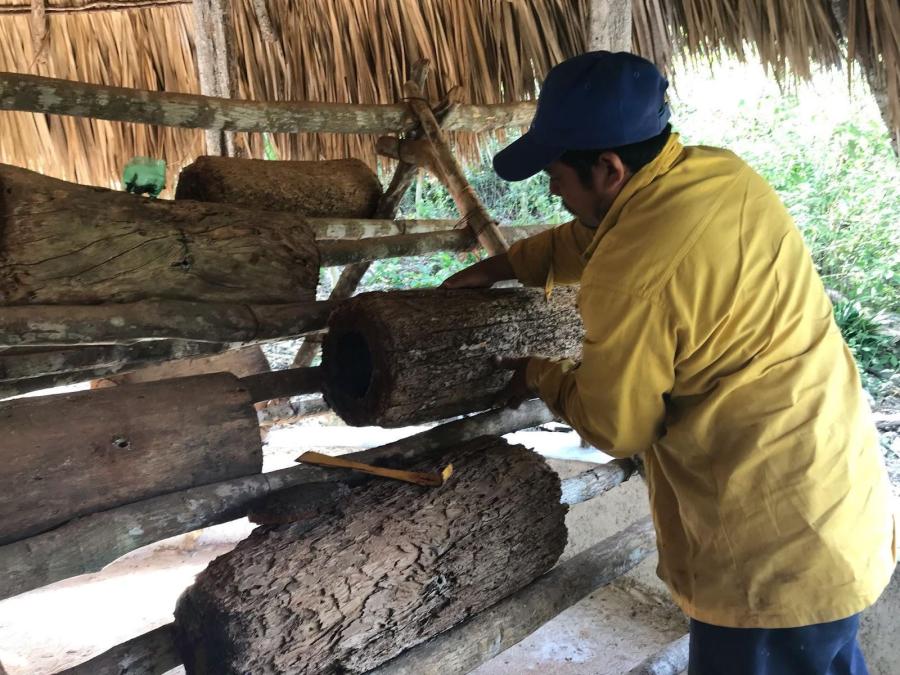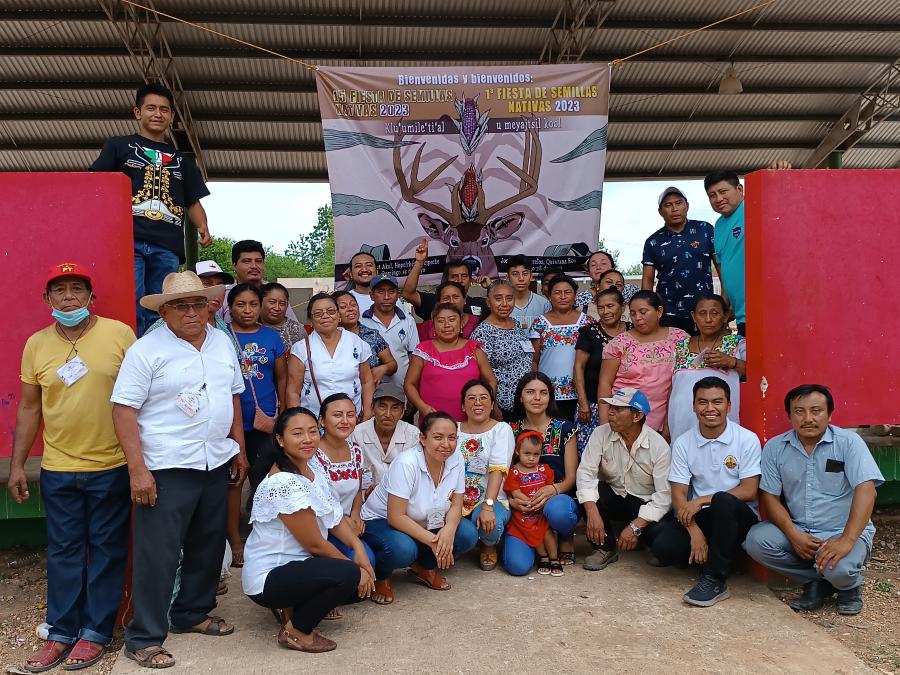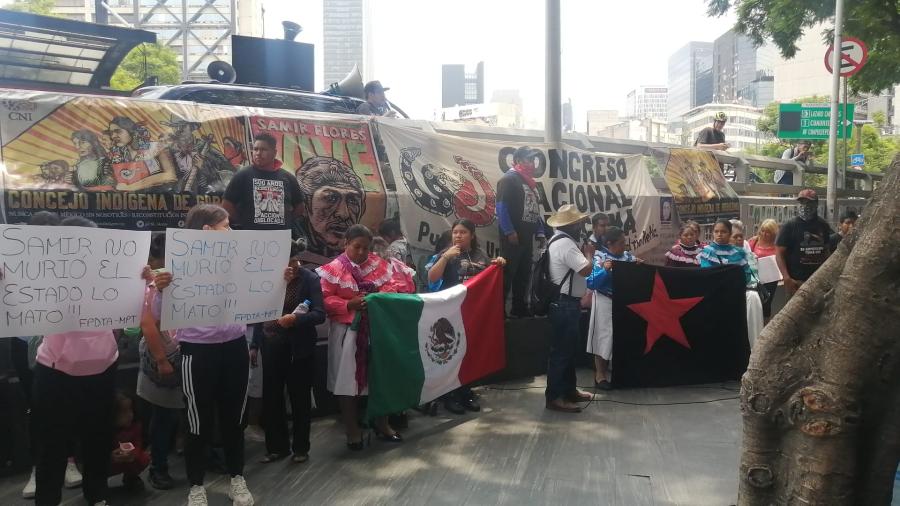
By Tracy Barnett of The Esperanza Project
MEXICO CITY – The old Mexico met the new one Saturday at the massive Foro Sol and together, in a vivid explosion of rhythm and light and living energy, they danced the night away.
Wirikuta Fest, a lineup of nearly 20 big-name recording artists, was as much a celebration of Mexico’s indigenous roots and living heritage as it was a rock concert. Organizers and participants agreed, nothing quite like it had ever happened in Mexico.
The sacred lands of the Wixarika or Huichol Indians, currently under threat by Canadian mining companies, have become a rallying point for Mexicans of all ethnicities who care about the environment and the plight of the country’s indigenous people. Wirikuta Fest brought together more than 60,000 of them in a thunderous rallying cry: Wirikuta is not for sale.
Wirikuta, a 140,000-hectare territory in the Chihuahua desert and Catorce mountains, is held sacred by the Wixarika as the birthplace of the sun, and has been the destination of their yearly pilgrimages for more than a millennia. It is also the place they gather their sacred cactus, the hikuri or peyote.
For thirteen hours, the people streamed into the stadium like a river. Some headed straight for the stage, where a lineup of Mexican and Puerto Rican superstars – Café Tacvba, Caifanes, Enrique Bunbury and Calle 13 among them – took the government to task, honored their Indian ancestors and the tribes that continue to fight for their lands, and celebrated the movement for a new Mexico, one that is free from violence against the people and against the Earth.
“This is the time that our grandfathers foresaw, the time when we all unite, the South with the North,” said Roco Pachukote of Sonidero Meztizo. “Strength for the people in our hearts, Wirikuta is not for sale!”
Rubén Albarrán, vocalist of the wildly popular Café Tacvba, took the opportunity to challenge the government on its announcement Thursday that it would set aside the sacred lands in a special reserve – a plan Wixarika leaders, upon inspection, called a complete farce.
“We have to be really careful with information because just a couple of days ago we were deceived with a media masquerade,” Albarrán warned the crowds between high-energy hits like “Cero y Uno” and “Ingrata.”
Albarran, Roco and his partner Moyenei form the core of the Aho Colectivo, the group of recording artists who have been working with the Wirikuta Defense Front to raise funds and awareness to support the cause.
“What is happening with Wirikuta is happening everywhere,” Albarran told the assembled thousands, who roared back their assent in cheers that literally made the rafters tremble. “They are poisoning our water, poisoning our land. It would seem that we are attending the big final sale of the end of the world; the political class is selling everything.”
Meanwhile, others wandered the quieter perimeter, where a ring of tents and tipis surrounded the stadium’s performance area, offering activities ranging from indigenous temazcal or sweat lodge ceremonies and Aztec dances to documentaries and talks on environmental and indigenous themes.
Concert-goers took a break to enter the darkness of the temazcal, to sweat, to purify and sing and pray. Others entered the tipi of the grandmothers to receive their quiet blessing. Booths were set up to allow the inhabitants of Wirikuta and the Wixarika people to sell their wares. And an “ecotechniques” tent took more than 3,000 participants on a tour through an astounding variety of eco-friendly technologies, demonstrating the use and construction of bicycle-powered blenders and water pumps, solar ovens and composting toilets.
From the beginning to the end, the event was woven through with a spiritual dimension, which resonated in the drums of the Camino Rojo warriors and in the plaintive cry of the Huichol fiddles. Not long after sunrise, the Mexica-Chichimeca dancers arrived on the scene with their towering plumed headdresses and their rattling ankle bracelets, set to work building altars in each of the four directions and sent up their prayers, asking for blessings for the event.
A council of grandmothers from different traditions arrived to conduct a prayer circle, and another group set up tipis, built four sweat lodges and began chopping wood for the fire that would heat the stones for the temazcales.
And from the stage, Wixarika vocalist José Lopez from the popular band Venado Azul invoked the assistance of Grandfather Fire, Father Sun and Mother Earth.
Jesus Lara Chivarra, a Wixarika elder and one of the leaders in the Wirikuta Defense Front, was amazed at the turnout.
“It’s incredible to see so many people,” he said. “This means the Wixarika spirit has won the hearts of the people, this I can see.”
Many of those he had spoken to throughout the day were confused by the government’s announcement on Thursday that the lands would be protected and returned to the Wixarika people. Gradually, he said, the news is getting out that the announcement was deceptive, that the lands they are turning over to the Huichols are only a small percentage of Wirikuta, and that the mines have not been halted.
“People will realize the Wixarika people have once again been deceived – and if they’re deceiving the Wixarika people they are deceiving the Mexican society as well,” he said. “This is the moment we invite the civil society not to stumble, to organize ourselves and to continue the work.”
Mercedes Aquino, one of the defense movement’s leaders and a resident of Real de Catorce, a former mining town at the heart of Wirikuta, was there helping promote the work of independent artisans and producers of the region, like Lorena Leon of the women’s cactus-growing cooperative Mujeres Rodeadas de Espinas (Women Surrounded by Thorns), and Jesus Perez and Benito Moreno, who turn plant fibers into a variety of products from tote bags to toilet paper holders.
The presence of the desert people at the concert was particularly meaningful, Aquino said, because there is a great deal of pressure in the area to support the mining projects due to the extremely depressed economy and the desperate need for jobs. Unlike the Wixarika people, who live from subsistence agriculture in the Western Sierra Madre 400 miles away, the mostly non-indigenous people of Wirikuta are hard-pressed to cultivate the dry desert lands. But these independent producers are showing sustainable alternatives to mining that won’t contaminate and dry up the scarce groundwater, Aquino said.
“People come in here and they are really amazed to see all the kinds of things that are produced in the desert,” she said. Cactus flowers, pickled and fresh; fruit jams and preserves and medicinal pomades and skin care products, all made of desert plants; handmade agave nectar; bags woven from the leaves of the yucca trees and lechugilla plants; and quiote, a sweet made from the sugar cane-like stalk of the maguey plant were just a few of the offerings.
In the tent next door, members of the Vision Council: Guardians of the Earth shared their vision for a more sustainable world, the same vision the group’s members carried through the Americas for 13 years in the Rainbow Peace Caravan, creating festivals much like this one, on a smaller scale.
“I really, really believe 2012 is the time of awakening,” commented Noelle Romero, author of the Manual Básico de Ecnotécnias, one of the group’s organizers. “I see it emerging everywhere – in Brazil, in Germany, in Colombia, in Spain. Everywhere people are empowering themselves to claim the world they want.
“When people say the world is ending, I cannot believe it when there is so much awakening. If there is a Great Spirit, this has to continue. This is the end of the world as we have known it – but I think it’s the dawn of a new world.”
People continued to stream into the stadium until the final acts of the evening, packing the stadium to its full capacity of 60,000.
“We are flying,” said an elated Luix Saldaña, a musician and one of the event’s main organizers, as the event began to wind down. “This is a unique event in Mexico; there’s never been an event like it, with an energy and an alternative proposal of this quality.”
The spiritual dimension of the event exceeded all expectations, said Saldaña, in terms of “the energy we’ve generated, in the type of public that came, in the energy that governs this entire event… it’s been more beautiful than we even hoped for. But the incredible thing is that the people who came … tuned into this channel of love and of unity and of spirituality.”
Saldaña attributed much of quality to the efforts of the people from various traditions who had come to offer their prayers and ceremonies to the event, but especially to the Wixarika people. About four busloads had made the three-day journey from their homes high in the Western Sierra Madre, and they were everywhere – on stage, in the audience, in the Wixarika tent, in the booths surrounding the stadium selling their characteristic brilliant, peyote-influenced artwork and jewelry.
“As you can see, these are Wirras from the sierra, not from the city – and this also added to the energy,” said Saldaña.
He stopped at the booth of Aho Colectivo members José Lopez, Claudia Carrillo de la Cruz and their small son, Yuawi, of Venado Azul were selling beaded jewelry, yarn paintings and their CDs. The money raised by this event is not going to the Wixarika people, but to the non-native people who inhabit their traditional pilgrimage lands, Lopez emphasized. His hope, and the hope of all the Wixarika people, is that this event will raise enough money to support an alternative to mining and to show the people of Wirikuta that the Huichol people really care about their well-being, and don’t just come to leave their offerings and their trash, as some local residents have complained.
“We want to make a sustainable project for them so the people from there can live like God meant them to.”
Lopez had never played before such a large audience, and he was still euphoric, hours after his performance.
“This event was incredibly vibrant and it continues vibrating now,” he said. “It’s a prayer we’ve made for the Mother Earth, for the deities – this moves the world. Wirikuta is not alone. Wow, it will stay engraved in my memory forever.”
For more information about the movement to protect Wirikuta, follow the Wirikuta Defense Front on theirblog, Facebook or Twitter, at @FDWirikuta or @Venadomestizo.










